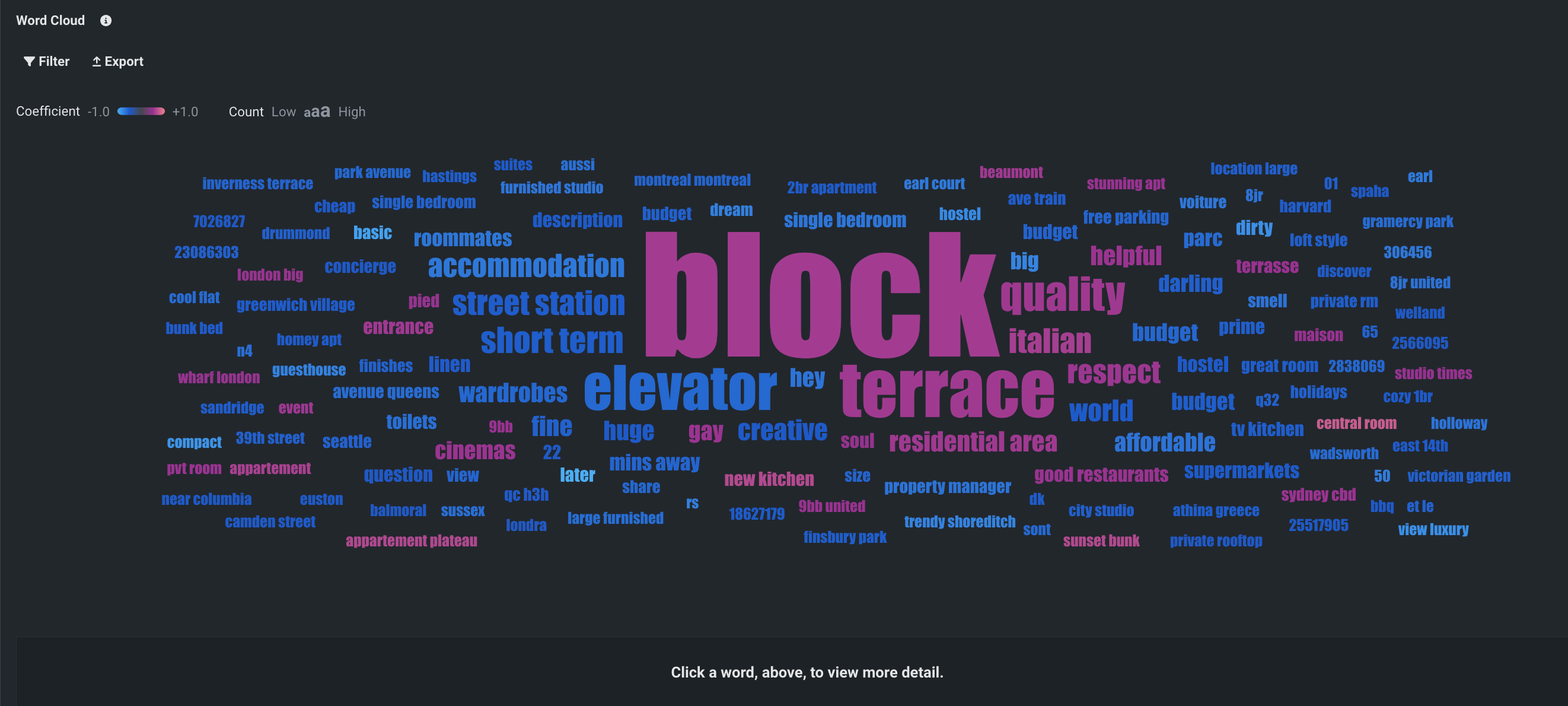Data, modeling, and apps (V10.1)¶
July 15, 2024
The DataRobot v10.1.0 release includes many new data, modeling, apps, and admin features and enhancements, described below. See additional details of Release 10.1 in the MLOps and code-first release notes.
10.1 release¶
Release v10.1 provides updated UI string translations for the following languages:
- Japanese
- French
- Spanish
- Korean
- Brazilian Portuguese
Features grouped by capability
| Name | GA | Preview |
|---|---|---|
| Experience | ||
| User experience changes to Workbench | ✔ | |
| Data | ||
| Perform wrangling on Data Registry datasets | ✔ | |
| Modeling | ||
| User experience changes to Workbench | ✔ | |
| Word Cloud now GA in Workbench | ✔ | |
| Composable blueprints now available in Workbench | ✔ | |
| Migrate DataRobot Classic datasets to NextGen | ||
| Max increment size increased for incremental modeling | ✔ | |
| Admin | ||
| Support for Hive JDBC with Kerebos authentication | ✔ | |
| Deprecations and migrations | ||
| ADLS Gen2 and S3 connectors versions | ||
This document also describes DataRobot's fixed issues.
Experience enhancements¶
User experience changes to Workbench¶
Each release brings a migration of new features from DataRobot Classic to NextGen, bringing the two experiences closer to parity. Additionally, improvements are always ongoing, particularly in Workbench.
Data¶
This release introduces several improvements and capabilities to Workbench:
- The data explore page now supports dataset versioning, as well as the ability to rename and download datasets. Additionally, the feature list dropdown is now a separate tab on the data explore page.
- Search has been added to the Add data modal.
- Autocomplete functionality has been improved for the Compute New Feature operation.
- You can now use dynamic datasets to set up an experiment.
Modeling¶
This release brings a variety of modeling improvements, including:
-
Sorting behavior on the Leaderboard has changed. Now, once at least one model has all backtests or cross-validation partitions computed, DataRobot auto-sorts models using this partition.
-
You can now control the number of workers available for modeling from the worker queue in the right panel.
-
When EDA2 is calculated, if DataRobot identifies features with target leakage, a badge is added next to each feature wherever Feature Importance is displayed.
-
You can now include or exclude the ordering feature when creating new feature lists for time series models.
Data enhancements¶
Preview¶
Perform wrangling on Data Registry datasets¶
You can now build wrangling recipes and perform pushdown on datasets stored in the Data Registry. To wrangle Data Registry datasets, you must first add the dataset to your Use Case. Then, begin wrangling from the Actions menu next to the dataset.
This feature is only available for multi-tenant SaaS users and installations with AWS VPC or Google VPC environments.
Preview documentation.
Feature flag(s) OFF by default: Enable Wrangling Pushdown for Data Registry Datasets
Modeling enhancements¶
GA¶
Word Cloud now GA in Workbench¶
Word Cloud, a text-based insight for classification and regression projects, is now generally available in Workbench. It displays up to 200 of the most impactful words and short phrases, helping to understand the correlation of a word to the target. When viewing the Word Cloud, you can view individual word details, filter the display, and export the insight.
Preview¶
Composable blueprints now available in Workbench¶
From the Leaderboard, you can access a model's Blueprint to see the high-level end-to-end procedure for fitting the model, including any preprocessing steps, modeling, and post-processing steps. Now, you can edit those blueprints using built-in tasks and custom Python/R code. Use your new blueprint, together with other DataRobot capabilities (MLOps, for example), to boost productivity. Editing the blueprint consists of modifying, adding, or deleting the blueprint's nodes and connectors. Validation messages report potential issues with the new pipeline. Once built, you can train the new blueprint from the editing window. Or, you can save it to the repository for later training.
Preview documentation.
Feature flag ON by default: Composable ML for Blueprints in Workbench
Migrate DataRobot Classic datasets to NextGen¶
Expanding on the asset migration feature previously added, all datasets associated with a DataRobot Classic project—in the AI Catalog to which you have owner access—are also migrated to NextGen so that you can fully leverage the power of Use Cases.
Preview documentation.
Feature flag ON by default: Enable Asset Migration
Max increment size increased for incremental modeling¶
While the default increment size for incremental modeling is 4GB, the increment (“chunk”) can now be increased to as large as 10GB. Organizational administrators can increase the maximum increment size to 20GB for their users with the Enable 20GB Scaleup Modeling Optimization feature flag enabled.
Preview documentation.
Feature flag ON by default: Enable Incremental Learning, Enable Data Chunking (10GB) Feature flag OFF by default: Enable 20GB Scaleup Modeling Optimization (20GB)
Admin enhancements¶
Preview¶
Support for Hive JDBC with Kerebos authentication¶
Support for Hive JDBC with Kerebos authentication has been added for DataRobot versions 9.2, 10.0, and 10.1.
Deprecations and migrations¶
ADLS Gen2 and S3 connectors versions¶
In the upcoming release of DataRobot 10.2, the ADLS Gen 2 ( versions 2021.2.1634676262008 and 2020.3.1605726437949) and Amazon S3 (version 2020.3.1603724051432) will be deprecated. It is recommended that you recreate any existing data connections using the new connector versions to benefit from additional authentication mechanisms, bug fixes, and the ability to use these connections in NextGen.
As of 10.2, the following preview feature flags will also be disabled:
- Enable DataRobot Connector
- Enable OAuth 2.0 for ADLS Gen2
The existing connections created using older versions will continue to work. Moving forward, DataRobot won't make any enhancements or bug fixes to these older versions.
All product and company names are trademarks™ or registered® trademarks of their respective holders. Use of them does not imply any affiliation with or endorsement by them.


